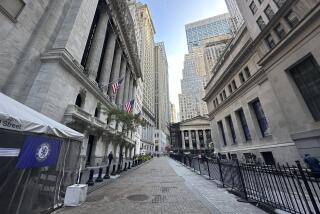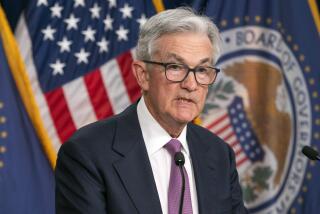Trump’s Fed pick, Jerome Powell, is likely to be tested early on interest rate policy
Reporting from Washington — President Trump’s choice for the next Federal Reserve chief, Jerome H. Powell, likely will face an immediate test as stronger economic growth exerts greater pressure on the central bank to step up the pace of interest rate hikes.
Trump has said he wants interest rates to stay low, and that presumably was an important consideration in the president’s decision, announced Thursday, to replace Janet L. Yellen with Powell, a Fed governor since 2012 who has closely aligned himself with the cautious policy moves and positions forged by Yellen. And like Yellen, whom he would succeed in early February if confirmed by the Senate, Powell has shown he is in no hurry to raise rates.
For the record:
3:25 a.m. Nov. 3, 2017An earlier version of this article stated that Randal Quarles, President Trump’s first nomination to the Fed board, was confirmed this month. He was confirmed in October.
But with the U.S. economy gathering steam and stocks surging to levels that have some worried, Powell soon could find himself in the uncomfortable position of having to build consensus around making more rapid rate increases, seldom a popular or easy thing to do. And some analysts think that job will be all the harder because Powell, unlike Fed chairs over the past four decades, is a not an economist. He is a lawyer and former investment banker.
Already debate is sharpening inside the Fed as policymakers at one end press to hold off on lifting interest rates while those on the other are keen to take more aggressive action to keep inflation in check. What’s more, the tax overhaul unveiled Thursday by Trump and congressional Republicans is likely to further push up interest rates if the cuts result in bigger federal deficits and debt, as expected.
“He’s got a very large challenge in that within the Fed, there’s a growing divide about the trajectory of rate hikes,” Diane Swonk, a Chicago economist and longtime Fed analyst, said of Powell. “He’s been straddling the middle,” she added. “The question is, can you straddle the middle and corral the cat?”
Trump had narrowed his search to five candidates in what he had made an unusually public race, taking a straw vote of finalists among lawmakers. One of them was Yellen, but Trump chose to break a four-decade tradition in which Fed chairs were renominated by presidents of opposing parties. On Thursday, as he stood in the White House Rose Garden to introduce Powell, Trump praised Yellen as “a wonderful woman who has done a terrific job.”
Many analysts noted that if Trump was looking for continuity, his best bet would have been to stick with Yellen. And some Senate Democrats expressed disappointment that the president had bypassed Yellen, saying that she deserved to be reappointed given the performance of the economy.
Senior White House officials defended Trump’s decision, saying among other things that Powell’s extensive business experience appealed to the president. Trump described Powell as smart and committed and said he would bring “real-world perspective to our government.” Trump also had previously indicated that he wanted to pick his own person for the job, which, despite its reputation for independence, is nonetheless a highly political appointment.
Besides Yellen and Powell, Trump had interviewed other candidates, including Stanford economist John B. Taylor, who have been critical of Fed policies and were seen as more inclined to push for faster rate increases.
Yellen, a Democrat, was tapped by President Obama for the four-year term. The former UC Berkeley economics professor will be the first Fed chair to serve less than two terms since G. William Miller’s short tenure as Fed leader from 1979 to 1981. In a statement Thursday, Yellen congratulated Powell and said that she is “committed to working with him to ensure a smooth transition.” She did not say whether she would stay on as a board governor when her term as chair ends Feb. 3.
Powell, 64, is a registered Republican. He was appointed by Obama in 2012 to fill a vacant seat on the Fed board and was easily confirmed. But occupying the high-profile, globally influential Fed chair is a whole other matter, and Powell is almost certain to face tough questioning from both the left and the right, on monetary policy as well as his views on financial regulations, where he differs more from Yellen.
Senate members will want to know in greater detail Powell’s thinking on the economy, in particular inflation, and the proper role or focus of the Fed, which has been a lightning rod topic on Capitol Hill. Yellen and her predecessor, Ben S. Bernanke, took unprecedented action to stimulate the economy by holding down interest rates and buying trillions of dollars of bonds to pump money into the financial system to spur lending. Republican critics saw the Fed as overly interventionist, and conservative economists such as Kevin Hassett, now head of Trump’s Council of Economic Advisers, claimed that the bank’s easy-money policies were a prelude to soaring inflation.
Inflation, however, has been surprisingly quiescent, running persistently below the Fed’s 2% target despite the long economic recovery and drop in unemployment. That has, to a large extent, stumped Fed officials — Powell has echoed Yellen in calling it a mystery — and has led policymakers to question whether the stubbornly low inflation may be a sign of economic weakness and give the Fed pause in raising rates.
In light of that and other uncertainties, Yellen has steered a course of very gradual rate increases and an equally slow removal of the bonds in the Fed’s portfolio. At its policy meeting Wednesday, the Fed stood pat on interest rates even as it described U.S. economic growth as “solid.”
Over the past four years, Powell has always voted with Yellen in policy decisions, and his speeches suggest that he favors a similarly cautious approach in raising rates and scaling back monetary support for the economy. Yet even as he has toed the Fed party line, most analysts say that Powell’s views on inflation are not well-known.
“I imagine him to be a bit less dovish than Yellen,” said Dean Baker, co-director of the Center for Economic and Policy Research, using a term that refers to a less aggressive stance on raising interest rates in favor of putting more emphasis on maximizing employment.
Ryan Sweet, who follows the Fed for Moody’s Analytics, said that one of the near-term challenges for Powell is addressing the disconnect in rate expectations between the Fed and financial markets. Most Fed officials see their benchmark interest rate, currently at 1% to 1.25%, rising over the next two to three years until it stabilizes at around 3%. Markets, however, think the longer-run rate will end up closer to 2%.
“He’s going to have to close that gap — and do it gracefully,” Sweet said, noting that otherwise, it could jar financial markets.
Powell’s biggest test, though, will come when the economy enters a downturn, which is a distinct possibility in the next four years as the current economic expansion is already more than eight years old, the third-longest on record. Some analysts wonder whether Powell’s lack of expertise in economics could hamper his ability to hold his own at the Fed’s mahogany table with other policymakers, some of whom are highly trained economists.
“The chairman needs to know what to do when the going gets tough,” said Chris Rupkey, chief financial economist at MUFG Union Bank in New York. “We are not sure how it is going to work to have a non-economist go before Congress and take questions on the highly technical and complex role that monetary policy plays in our economy.”
Other analysts say Powell’s speeches show he has a solid handle on the economy and monetary policies, thanks to his experience at the Fed, in the private investment world and having previously served as the Treasury Department undersecretary for finance in the early 1990s. For technical matters, these analysts said, Powell can rely on the army of economists that make up the staff at the Fed.
“It’s far more important to be able to absorb and understand high-quality economic analysis than to have a certificate or a PhD,” said Kim Schoenholtz, a professor at the Stern School of Business at New York University.
Schoenholtz and others who have seen Powell speak and engage with audiences say that he knows how to communicate effectively, and several former Fed board members, including some who had worked with him, said Powell was a consensus builder. Before joining the Fed, Powell had been a visiting scholar at the Bipartisan Policy Center think tank and a partner at the Carlyle Group, a high-powered Washington, D.C., asset-management firm.
“He’s had a long experience at the Fed, and he’s been part of the process of creating consensus there about policy,” Schoenholtz said.
Unlike Yellen, who has been a staunch defender of stricter banking regulations put in place after the 2008 financial crisis, Powell is seen as more likely to ease some of those rules, particularly for smaller banks. In that, he already would have an ally in Randal Quarles, Trump’s first nomination to the Fed board who was confirmed last month and is now the central bank’s vice chair for bank supervision.
Apart from the Fed chair, there are three other vacancies on the Fed’s seven-member board, including the vice chair. Those positions would allow Trump to broadly reshape the Fed, leaving his imprint on the most powerful central bank in the world.
Follow me at @dleelatimes
UPDATES:
2:10 p.m.: This article has been updated with Trump’s comments.
This article was originally published at 12:05 p.m.
More to Read
Inside the business of entertainment
The Wide Shot brings you news, analysis and insights on everything from streaming wars to production — and what it all means for the future.
You may occasionally receive promotional content from the Los Angeles Times.











